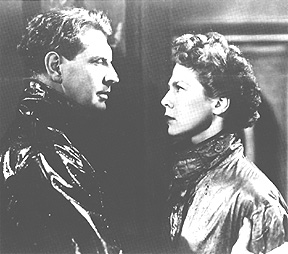April 11: "The Life and Death of Colonel Blimp" (1943)
It was scandalous enough to portray a forty-year friendship between an English career soldier (Roger Livesey) and a German one (Anton Walbrook) at a time when Britain was losing a war, but this glorious Technicolor epic earned the ire of Winston Churchill by also daring to satirize Britain's military mind, showing how ritual and manners facilitate war, and suggesting-from the mouth of a German officer-that the time for fair fighting was over. Livesey is perfection as Clive Candy, the titular thick-head based on a David Low cartoon which lampooned Chamberlain and the appeasers. From the 1902 Boer War through World War I and World War II, we see him go from brash young man to the type of staid elder he once despised, evolving as convincingly as Orson Welles in "Citizen Kane." While both "Kane" and "Blimp" were cautionary, the former was disdainfully pessimistic while the latter ultimately put its faith in the saving power of friendship and love. Butchered in its original American release, Pressburger's cyclical structure, revealed in flashback, has been restored, making it clear that the "Death" in the title is in fact a rebirth. Along the way, we meet the three women Candy loved and lost, all played by Deborah Kerr. It's an audacious stroke of genius: Kerr's reverberating presence not only emphasizes Candy's missed chance as time passes, but makes the mystical suggestion that rebirth is a liberating and timeless realization that all chances come at once.
 |
|
|
April 25: "I Know Where I'm Going!" (1945)
A sense of adventure and eager discovery permeates this enchanted love story. The headstrong Joan Webster (Wendy Hiller) has known since birth where she is going. She's determined to get to the Isle of Kiloran in the Western Isles of Scotland to join her aged millionaire boss in marriage. At the landing, however, she encounters thick fog and, later, as she waits at the stop-over house for it to clear, a great threat to her plans: the husky-voiced, affable Navy man, Torquil (Roger Livesey), who is attracted to her. She senses she must quickly escape; Torquil is like a whirlpool nearing her heart, but her prayers for a fog-clearing wind result in a gale, making it even more difficult to leave. Powell and Pressburger lace this intensifying dilemma with humor, surreal touches, and off-beat characters who nevertheless ring true. While maintaining a lilting, light touch, they make it clear that the struggle for Joan's heart is also a serious struggle for her soul. One wonders how many people her materialistic fiance had to step on to get to his position, while Joan's increasing determination to break free finally puts others in serious danger. Ultimately, it's the spiritual pull of the Scottish landscape and its people who love it more than money that convince her to stop struggling against the currents of love.
May 9: "Black Narcissus" (1947)
A party of nuns is invited by the local ruler to start a school in a disturbing, deserted palace perched on a steep ledge in the Himalayan Mountains where a former Rajah had kept his women. Once again, Powell and Pressburger present the real and the romantic as a harmonious yet disturbing dichotomy. Mr. Dean (David Farrar) is the handsome Englishman whose presence may be reviving Sister Clodagh's (Deborah Kerr) unsettling memories of a long-ago love affair, and inflaming passion and murderous jealousy in the unstable Sister Ruth (Kathleen Byron). At the same time, their unease is amplified by the mystical suffusion of pagan spirituality in the thin air, beating drums, perfumed aromas, and incessant winds, while the budding courtship between a young native general (Sabu) and an intoxicating native girl (Jean Simmons) unfolds in their midst. Of all their films, "Black Narcissus" comes closest to Powell's goal of creating a fully "composed film." Though it transports us to a foreign place, it was shot entirely on sets in England. Powell's ability to completely control all the natural and cinematic elements, Alfred Junge's astonishingly exotic, authentic-feeling art direction, and Jack Cardiff's Oscar-winning Technicolor cinematography produced a uniformity of atmosphere that keeps us spellbound from beginning to end. It's the Himalayas of our dreams.
May 16 : "The Red Shoes" (1948)
Pressburger was usually a moderating influence on the flamboyantly imaginative Powell-but not in this case. After the war, the public was hungry for art, and "The Red Shoes" is an art film with a vengeance. Based on the Hans Christian Andersen children's story about a girl who is destroyed by a pair of enchanted red shoes, it's the story of a ballerina (Moira Shearer) who is fatally torn between a life devoted to dance, as offered her by a ballet company's impresario (Anton Walbrook), and her love for a bright young composer (Marius Goring). Walbrook's Lermontov is a brilliant amalgam of seductive patriarch, ruthless autocrat, and self-loathing obsessive. The film's showpiece sequence is a fever dream 14-minute ballet that becomes a surrealistic language of the dancers' unconscious reflecting the psychological drama unfolding behind the scenes. Powell's daring accomplishment is not that he made a film about art devouring a life, but that he invited art to devour his film, and still succeeded in absorbing us in the lives of his characters. Despite its ultra-vivid use of Technicolor (red especially almost becomes an additional character), and its startling editing and compositions, it joins films like Charles Laughton's "Night of the Hunter" and David Lynch's "Blue Velvet" as examples of how high stylization can directly contribute to a heightened sense of emotional and psychological reality.
 |
 |
 |
 |
 |
Contents on this page were published in the April/May, 1996 edition of the Washington Free Press.
WFP, 1463 E. Republican #178, Seattle, WA -USA, 98112. -- WAfreepress@gmail.com
Copyright © 1996 WFP Collective, Inc.
